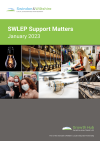Jon Faulkner, Managing Director of Domain7 UK, discusses how the future of local government rests in the hands of communities
Like the rest of society, local government organisations have been faced with unprecedented change during the course of 2020. More than ever before, they are under immense pressure to ensure that services keep running efficiently in a landscape which is continually shifting and priorities changing. Keeping in touch with their communities remotely is a vital part of the picture but are they set up to deal with a world that is more virtual than face to face for the foreseeable future? And where should their priorities lie as they seek to move on post COVID-19?
Where we are now
Many local government technology platforms have not been updated for many years and rely on old, legacy systems that are hard to change and not intuitive for internal or external users. On top of this many public sector bodies have traditionally fallen back on the old way of doing things – phone calls and letters – to communicate with their communities. This is a slow, one way process and it’s hard to gauge easily what your users really want.
The COVID pandemic has highlighted the need for rapid change to meet the needs of local communities in what is fast becoming a more virtual world. Digital and organisational change is required now that puts users and service designed digital platforms front and centre. The latest public sector technology procurement roster which closed for applications in July – the G-Cloud 12 framework – is a step towards this as it should help to streamline the often bureaucratic process of public sector contracting providing a mechanism that allows trusted technology suppliers to get their cloud related technology in front of procuring organisations more quickly.
Finding out what local communities really think about their services
The future of local government communities lies in designing digital systems that put people first. The key to true digital transformation of local government and the way that services are delivered requires a shift in thinking right through from the top to the bottom of the organisation as well as collaboration with the communities they serve. This gives both voice and power to the service-consuming public in the design decision making process. If systems are designed with user requirements front and centre, they will be more efficient, easier to use and more relevant to the end users. We all know that local government continues to struggle with too little funding to cover all the services they provide, yet the scale of need within communities who use their services has only continued to grow. This means that they have to prioritise where they should best spend their money and finding out what their communities really want should be a central part of the fact finding process as this will ultimately will lead to better systems designed to meet their needs.
New digital technology platforms like CivilSpace, which has proved successful in Canada and recently launched in the UK, provide a new and easy to use space for users to give feedback to their local authorities on how they would like to see their money being spent. By replacing phone and postal surveys with intuitive technology like CivilSpace to communicate with users, interaction with local users can be transformed, allowing a freer flow of ideas and a better understanding of what really matters to local people.
What about hard to reach communities?
There will always be pockets within communities that don’t have access to digital services. Unfortunately, local government is just not well funded enough to be able to pick up everything within their limited budgets so some radical and creative thinking is needed to come up with solutions.
One way forward may be to utilise the burgeoning numbers of volunteer groups that have sprung up as a result of the pandemic, providing support to people that otherwise would have been left stranded. Perhaps, by funding community organisations and local charities to fact find within hard to reach groups, rather than spending budget on paper based and phone based surveys, local government bodies could help to build a community spirit as well as a strong network of supportive groups that work and represent people in the heart of the communities that they live in.
A shift in thinking for the future of local government
Across all community sectors—including government, health, libraries, education, transport, and financial institutions – a shift in thinking is required. It is clear that leadership teams must invest in service designed systems that are built with people in mind. This means embracing change across an organisation, from the way leadership makes strategic decisions, to the way teams build and deliver services. Applied well, service designed strategies can strengthen internal cultures, deepen customer research, and increase agility while meeting the needs of local groups.
Service design is more about embracing a shift in the way an organisation thinks, problem-solves, innovates, and makes decisions to create a more forward-facing, future-ready organisation that can consistently deliver an excellent standard of service to its community.
My experience is that the days of one off digital projects that soon go out of date are numbered as we start to see long term collaborations taking place between digital change organisations and
service providers. Local government can only stay relevant by continually optimising processes and services. It cannot and must not be a one off process that takes place once every ten years.
Digital change in local government requires people and culture to change so that it works with the people and for the people. Technology is the key to that change and it must be user tested so that it is easy to use and relevant. It is incumbent upon the public sector to embrace a new way of doing things – informing and training people in new services that are fit for purpose in our new digital world.
Editor's Recommended Articles
-
Must Read >> Putting communities at the heart of policy-making





























